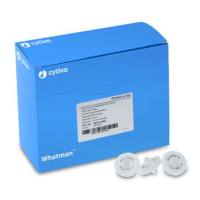Rapid Separation of Protein‐Bound DNA from Free DNA Using Nitrocellulose Filters
互联网
- Abstract
- Table of Contents
- Materials
- Figures
- Literature Cited
Abstract
Nitrocellulose binds proteins but not double?stranded DNA. Use of radioactively labeled double?stranded DNA fragments allows quantitation of DNA bound to the protein, permitting kinetic and equilibrium studies of DNA?binding interactions. In the basic procedure, purified protein is mixed with double?stranded DNA and then the mixture is filtered through nitrocellulose, allowing unbound DNA to pass through the filter while the protein (and any DNA interacting with it) is retained. When the binding site of a protein is unknown, the pure protein can be added to a mixture of fragments to select those fragments of DNA for which it has the greatest affinity. Specificity of binding can be influenced by the buffer conditions and filtering regimen. An is provided that creates conditions that disrupt weaker, presumably nonspecific binding interactions, while retaining the stronger binding interactions. The goal is to recover enough of a single input fragment to visualize by subsequent autoradiography. In some cases the quantitation (by scintillation counting) of DNA retained is not sufficient information. A describes how the DNA can be recovered from the filters for further analysis by gel electrophoresis or amplification and cloning.
Table of Contents
- Alternate Protocol 1: Detection of Specificity in DNA Binding
- Support Protocol 1: Elution of Bound DNA
- Reagents and Solutions
- Commentary
- Figures
Materials
Basic Protocol 1:
Materials
Alternate Protocol 1: Detection of Specificity in DNA Binding
Additional Materials
|
Figures
-

Figure 12.8.1 (A ) A single filtration apparatus can be set up with a sidearm flask connected to a vacuum source. The tubing arrangement need not be precisely as depicted but should include an adjustable clamp on a vent to allow precise control of the vacuum. (B ) The 10‐well filtration apparatus from Hoefer contains a removable rack for collection vessels. Many types of tubes or vials can be held in place by a rubber band as shown. Stopcocks allow vacuum to be shut off to any subset of the 10 wells, so that any number of samples from 1 to 10 can be filtered at one time. The lower tubing connector can be set up with tubing and a clamp to regulate the vacuum as with the vent on the sidearm flask unit. In both setups the interlocking design and weight of the steel are sufficient to create a seal around the filter. View Image -

Figure 12.8.2 Plot of increasing concentration of protein vs. amount of DNA retained (expressed as % of total input labeled DNA in cpm). In this example, plateau occurs when 70% of labeled DNA is bound. Therefore, the half‐saturation point is when half of this possible maximum is reached—i.e., when 35% of labeled DNA is bound. The concentration of protein necessary to achieve this half point is an experimental estimate of the Keq (see discussion in background information). View Image -

Figure 12.8.3 Two alternative ways to plot the results of a dissociation curve. Here the initial value of 100% equals the maximum amount of labeled DNA (measured in cpm) retained at the start of the experiment. Even though the maximum possible may only be 70% of the input labeled DNA (as shown in Fig.), if an amount of protein is used close to this plateau then this 70% value is the starting point for any dissociation and is therefore defined as 100%. The semi‐log plot uses a log scale for the cpm bound to represent the data as a straight line whose slope is−k1 , the dissociation constant (see background information and Barkley et al., ). View Image
Videos
Literature Cited
| Literature Cited | |
| Barkley, M.D., Riggs, A.D., Jobe, A., and Bourgeois, S. 1975. Interaction of effecting ligands with lac repressor and repressor‐operator complex. Biochemistry 14:1700‐1712. | |
| Fried, M. and Crothers, D.M. 1981. Equilibria and kinetics of lac repressor‐operator interactions by polyacrylamide gel electrophoresis. Nucl. Acids Res. 9:6505‐6525. | |
| Hinkle, D.C. and Chamberlin, M.J. 1972a. Studies of the binding of Escherichia coli RNA polymerase to DNA I. The role of sigma subunit in site selection. J. Mol. Biol. 70:157‐185. | |
| Hinkle, D.C. and Chamberlin, M.J. 1972b. Studies of the binding of Escherichia coli RNA polymerase to DNA II. The kinetics of the binding reaction. J. Mol. Biol. 70:187‐195. | |
| Hinkle, D.C. and Chamberlin, M.J. 1972c. Studies of the binding of Escherichia coli RNA polymerase to DNA III. Tight binding of RNA polymerase holoenzyme to single‐strand breaks in T7 DNA. J. Mol. Biol. 70:197‐207. | |
| Jones, O.W. and Berg, P. 1966. Studies on the binding of RNA polymerase to polynucleotides. J. Mol. Biol. 22:199‐209. | |
| Lin, S.‐Y. and Riggs, A.D. 1972. Lac repressor binding to non‐operator DNA: Detailed studies and a comparison of equilibrium and rate competition methods. J. Mol. Biol. 72:671‐690. | |
| Lin, S.‐Y. and Riggs, A.D. 1975. The general affinity of lac repressor for E. coli DNA: Implications for gene regulation in procaryotes and eucaryotes. Cell 4:107‐111. | |
| Nirenberg, M. and Leder, P. 1964. RNA codewords and protein synthesis: The effect of trinucleotides upon the binding of sRNA to ribosomes. Science 145:1399‐1407. | |
| Ptashne, M. 1987. A Genetic Switch: Gene Control and Phage λ, pp.80‐83 and 109‐118. Cell Press, Cambridge, MA and Blackwell Scientific, Boston, MA. | |
| Riggs, A.D., Suzuki, H., and Bourgeois, S. 1970. Lac repressor‐operator interactions: I. Equilibrium studies. J. Mol. Biol. 48:67‐83. | |
| Strauss, H.S., Burgess, R.R., and Record, M.T. Jr. 1980a. Binding of Escherichia coli ribonucleic acid polymerase holoenzyme to a bacteriophage T7 promoter‐containing fragment: Selectivity exists over a wide range of solution conditions. Biochemistry 19:3496‐3504. | |
| Strauss, H.S., Burgess, R.R., and Record, M.T. Jr. 1980b. Binding of Escherichia coli ribonucleic acid polymerase holoenzyme to a bacteriophage T7 promoter‐containing fragment: Evaluation of promoter binding constants as a function of solution conditions. Biochemistry 19:3504‐3515. | |
| Strauss, H.S., Boston, R.S., Record, M.T. Jr., and Burgess, R.R. 1981. Variables affecting the selectivity and efficiency of retention of DNA fragments by E. coli RNA polymerase in the nitrocellulose‐filter‐binding assay. Gene 13:75‐87. | |
| Key References | |
| Ptashne, 1987. See above. | |
| A straightforward introduction to DNA‐binding interactions and equations and a good place to start for theory. | |
| Riggs et al., 1970. See above. | |
| An early paper covering the underlying theory and limitations of the filter‐binding technique. In addition to actual data it provides detail on most applications described in this protocol, and is an excellent source of practical information. |









